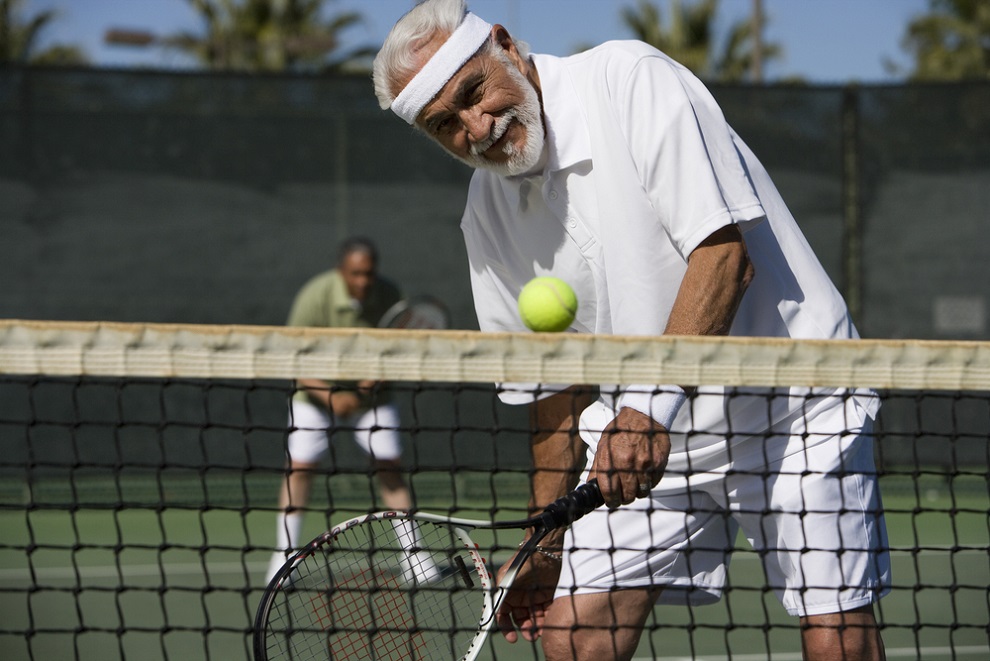How to improve grip strength may seem like an odd question to ask but having a strong grip is not only important for strength training, but it is also vital to keeping your body healthy as you age. Grip strength serves as a marker of overall health and is a reliable predictor of both physical and cognitive deterioration over time.
Studies show that poor grip strength is an indicator of chronic conditions and decreases physical and mental ability as you age. The best way to make your grip strength stronger is to work on your upper body and forearm using compound movements.
If you are looking for ways to improve your grip strength, we have a list of exercises you can perform to help strengthen your grip.

What is Grip Strength?
Grip strength measures the force and tension your forearm muscles generate. It is often used to track a person's upper body strength. People use grip strength for everyday tasks like carrying tools or holding pencils. Grip strength is also important in sports such as golf, rock climbing, tennis, and bowling.
When your body grabs, presses, crushes, rotates, or pinches, a combination of intrinsic hand muscles and extrinsic gripping muscles work together to form these movements. The intrinsic hand muscles such as your thenar and hypothenar muscles or your lumbrical muscles, perform the fine motor skills and preciseness of these exercises.
Your extrinsic muscles, such as the flexor pollicis longus and palmaris longus create the force and control you need. When a man reaches midlife, medical professionals use grip strength as an essential biomarker to evaluate and predict physical ability later in life. It indicates muscle strength, muscle mass, bone mineral density, and nutritional status.
Grip strength is also used to predict the incidence of chronic diseases such as Type 2 diabetes, heart disease, arthritis, osteoporosis, and cancer. Your grip strength is an indicator of how healthy you are overall, which is why it is important to learn how to increase grip strength.
What Are the Types of Grip Strength?
There are a few different types of grips, we will go over some of the basic ones: crush grip, pinch grip, and hook grip. Understanding the different types of grips can help you understand how you use grips in your everyday life.
Crush grip is when you close your hand firmly around an object. In this motion, you are attempting to compress the object by exerting force on it. You perform this task when you squeeze a wet sponge as you wash your car or cut wires with wire cutters. Crushing grip is the type of grip most people picture when they think of grip strength.
Pinch grip is using your thumb and finger to exert force on an object. You use this grip type to turn keys, use scissors, and perform many intricate fine motor skills. This type of grip is all about the precision and dexterity of the hand.
Hook grip is when you use your fingers to create a hook shape. Often the shape you make with your hand is somewhat like a flat C, then your thumb is used as a stabilizer, but your hands will look different according to the object your hand is gripping. You use this grip to play musical instruments, type, write, open jars, and use your phone.
Gripping is such a mundane and natural part of our days that it seems we forget how much we need grip to perform daily tasks. That is why you need to understand ways to improve grip strength to keep your physical mobility as you age.

How Do You Test Grip Strength?
A medical professional may perform a grip strength test with a device called a dynamometer. A dynamometer can use either hydraulics or electronic load cells to measure force. The device typically has a handle and a gauge at the top where a doctor makes the reading. A person will get in a grip position and squeeze the handle.
The needle on the gauge will point to the amount of force you are exerting, which you will need to hold for a few seconds. The reading will be recorded. Usually, the average of three scores will be taken as your grip strength. Digital dynamometers will be easier to read, as they will display the number in PSI (pounds per square inch) or in kilograms.
You can also take your own grip strength at home. Many websites online sell dynamometers you can use. Normal ranges for grip strength vary by age and sex. Your right and left-hand grips will vary, as well, since one hand is typically more dominant than the other.
Males from 50-54 years old typically have a grip strength of about 56.35-98.59 pounds. However, it is important to consult your healthcare professional to make sure that your readings are appropriate for you.
What Are the Best Ways to Improve Grip Strength?
You are ready to learn how to get a better grip, but where do you start? Improving your grip strength can be done by adding some simple exercises to your daily routine. The best exercises for grip strength will be using your hands and your upper body to lift, pull, and carry weights.
You can perform some of these exercises at home using home gym equipment, or you can go to the gym for more intense workouts. For individualized grip strengthening, you may want to seek out a personal trainer to help you get started with training exercises specifically designed for weak grip.
Working out will not only improve your grip strength but will help keep your whole body healthy, which is essential as you age. If you have not exercised in a long time or if your grip strength is particularly weak, make sure to take it slow at first. As you continue to exercise, you'll be able to do more and more.
Try out the following exercises to strengthen your grip.
#1 Farmer's Walks
With this exercise, also called a farmer's carry, you need to identify the heaviest object you can lift from the ground using your hands. It is ok to start small and work up to heavier objects. You can use weights for this exercise.
With this exercise, you will lift the heavy object from the ground and walk as long as you can while carrying the object. If you begin to tire, simply put the weights down. Take a breather and try it again. This will help with hand grip strength. As you build resistance, you can begin to use heavier weights.
#2 Reverse Grip Barbell Curl
For this exercise, you will need a barbell. You will hold the bar in both hands with your palms facing down. Then, you will curl the barbell up and down. You can increase the difficulty as you improve by letting the weight roll to the end of your fingers and away from your palm at the bottom of the curl.
#3 Pull-Ups and Dead Hangs
Pull-ups: Pull-ups involve lifting your body weight using your arms to pull yourself up until your chin clears the bar. This exercise targets the muscles of the back, arms, and shoulders, as well as the core. To perform a pull-up, start by hanging from a pull-up bar with your palms facing away from you. Then, engage your back and arm muscles to pull yourself upward until your chin reaches or clears the bar, then lower yourself back down with control.
Dead Hangs: This is a similar exercise that involves hanging freely from a pull-up bar with your arms fully extended and your shoulders relaxed. The primary goal of dead hangs is to build grip strength and improve shoulder stability. To perform a dead hang, grasp the bar with an overhand grip (palms facing away from you) and hang for a predetermined amount of time or until fatigue sets in. Dead hangs primarily target the muscles of the forearms, hands, and shoulders.
While both exercises can contribute to upper body strength and fitness, dead hangs primarily focus on grip strength and shoulder stability, while pull-ups target a wider range of upper body muscles. Incorporating both exercises into your workout routine can provide comprehensive benefits for overall strength and fitness.
#4 Kettlebell Swings
A thick kettlebell handle will help you to improve your grip strength and challenge your hand muscles. With this grip strength exercise, you will firmly grip the handle with both hands. Then, swing the kettlebell between your legs as you bend over.
Next, swing the kettlebell away from your body as you rise to a standing position. Continue this exercise for several reps. As you get better, you can perform the exercise in opposite directions.
#5 Push Ups
Another easy exercise for home grip training is to perform push-ups. Place your body in a plank pose with the body prostate, the back, and legs straight, and lift your body by pushing up with your open palms on the floor. Use the tips of your toes to hold the position. Repeat as often as you can tolerate.
#6 Tennis Ball Squeeze
For this exercise, hold a tennis ball in your right hand. Face your palm up and bend your elbow to 90 degrees. With your four fingers, squeeze the ball as hard as possible. Hold the squeeze for 5 seconds, then release the grip. Repeat this exercise 10 times. You can perform this exercise throughout the day to strengthen your grip.
#7 Reverse Wrist Curls
Either holding a barbell in both hands or a dumbbell in each hand, sit upright on a bench. Grip the barbell or dumbbells with your palms down to create an overhand grip. Lean forward and place the forearms on your knees. Keeping your forearms on your legs, bend your wrists back, and lift the weight. Then, slowly lower it, curling your wrists down. Do about 2 or 3 sets of 10 to 15 reps.
#8 Deadlift
Your feet should be shoulder-width apart. Stand up straight with a neutral back position. Lower your hips by bending your knees while keeping your back flat. Grab the bar, keep your core engaged and your chest upright as you slowly stand. This will engage the glutes and work your entire body.
#9 Plate Pinch
With a 10-pound weight plate, place the plate to rest against your calf. Squat down and grab the plate with your four fingers on the outside. Use your thumb to pinch it. Then, stand up. Hold the plate for 10-15 seconds.
Then, squat down to rest. Repeat this exercise 10-20 times, being sure to switch sides. As you get better at this exercise, you can increase the weight. You can also up the difficulty by walking while pinching the plate.
#10 Dead Hang
Using a pull-up bar, grab the bar with your palms facing away from your body about shoulder-width apart. Then, hang your arms straight with your core engaged. Start by only hanging for 20 seconds at a time. Eventually, you can move up to longer periods of time. Repeat this exercise 5-10 times.
What Causes Poor Grip Strength?
Grip strength naturally wanes with age. If you've recently had your hand in a cast, your muscles may be weak, and with physical therapy, you should be able to get them back to their original strength. Some other issues besides breaks and age can cause poor grip strength, including the following:
- Carpal tunnel syndrome
- Cubital tunnel syndrome
- Epicondylitis
- Pinched nerve
- Arthritis in the hand
- Sarcopenia
- Peripheral neuropathy
- Multiple sclerosis
- Stroke
- Ganglion cysts
If you have poor grip strength accompanied by other symptoms such as pain or swelling, you may want to speak to your healthcare provider to make sure it is not a result of one of these conditions or something else not listed.
A medical provider will be able to treat any issues that may be affecting your grip strength. They may also recommend other ways that you can work to improve your overall health as you age. If you're looking for a way to combat aging and restore energy, sleep deeper, define muscles, and improve your mental clarity, you should consider testosterone replacement therapy (TRT).
Here at Male Excel, we make it convenient and safe to get TRT therapy online. TRT replenishes your body to optimal hormone levels, so it can perform at its peak.
Conclusion
Grip strength is an important predictor of men's overall strength and health as they age. It is important to maintain a stronger grip through strength and resistance training. By performing these exercises, you can help to improve your upper body strength and increase your chances of better physical and mental health as you age.
You can test your grip strength at home or ask your healthcare provider to perform a grip strength test to see where you stand and give you suggestions for how to make your grip stronger. Improving your grip strength will help your overall health improve.

Find out if TRT Can Help You
TRT from Male Excel





